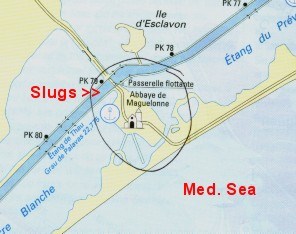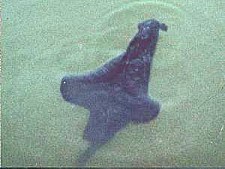Mass Congregation of Aplysia fasciata
February 23, 2001
From: Hans Rothauscher


In June 2000 we saw masses of seahares [Aplysia fasciata] on the 'Canal du Rhône à Sète' in southern France, drifting with the current towards the Étang de Thau. They swam actively, grazed from rocks and the bottom of our boat. Next day they were gone.
The Canal, an extension of the Little Rhône, runs as an inland waterway along the coast through large shallow saltlakes and marshes. It is connected with the lakes through many floodgates. It has quite a current and I don't believe that it is the normal habitat of the seahares. I rather think that they normally live in the lakes.
Any suggestions as to what caused the temporary gathering? We believe that the animals were on their way to a mass marriage, probably in the Étang de Thau. This happened 2 days before the full moon, and we know that many invertebrates have such fixed annual reproduction "appointments".
Hans Rothauscher
http://home.t-online.de/home/rothauscher/
Rothauscher@t-online.de
Rothauscher, H., 2001 (Feb 23) Mass Congregation of Aplysia fasciata. [Message in] Sea Slug Forum. Australian Museum, Sydney. Available from http://www.seaslugforum.net/find/3856Dear Hans,
Thanks for the message. Finding large 'swarms' of Sea Hares is indeed an interesting experience, and it has been observed throughout the world with different species. The general feeling is that these 'swarms' are not migrations. Have a look at the messages on the Aplysia brasiliana page, where there are many reports of 'swarms' in Florida. Also have a look at the Mass Mortality page for more information and examples. In brief, these swarms appear to be the result of synchronised life cycles. Since they all spawn about the same time, large numbers reach maturity about the same time. You will certainly find many of the swarm mating, often in chains of 3 or 4, but they haven't formed the swarm to mate, they are mating because they are all close together.
Concerning your suggestion of 'mass marriages'. Many marine invertebrates do have mass reproductive events which are often synchronised by the phases of the moon. However these usually occur in groups of invertebrates [corals, polychaete worms, sea urchins] which are either unable to move, or do not mate or copulate. To reproduce they simply release their eggs and sperm in to the sea. The sea is a very big place, so by synchronising their spawning, these animals greatly improve the chances od a sperm finding, and fertilising, an egg of the same species. Not quite as romantic as the idea of synchronised mass marriages, but it works.
Best wishes,
Bill Rudman
Related messages
-
Re: Aplysia brasiliana = Aplysia fasciata?
From: Bill West, February 13, 2009 -
Variation in egg mass color in Brazilian Aplysia fasciata
From: Vinicius Padula, July 10, 2008 -
Aplysia fasciata from Portugal
From: Valter Jacinto, July 2, 2008 -
Sea Hares washed up in Devon, UK
From: Rob Benzies, April 9, 2008 -
Swimming sea slug in France
From: Tim Twibell, October 4, 2007 -
Aplysia fasciata in western France
From: Michael Keys, September 3, 2007 -
Swimming Aplysia in Portugal
From: Gary Leman, August 20, 2007 -
Unidentified Sea Slug from Spain
From: David Gilbert, July 18, 2007 -
Have I been poisoned?
From: Pete Baker, July 17, 2007 -
Aplysia fasciata and A. punctata from Antibes
From: Dominique Horst, June 1, 2007 -
Aplysia fasciata from Greece
From: Hilary Cunliffe-Charlesworth, September 11, 2006 -
Aplysia fasciata? from the Canary Islands
From: Christian Kowalewski, August 21, 2006 -
Swimming Aplysia fasciata from Oeiras, Portugal
From: Ricardo Gomes Afonso, August 9, 2006 -
Are those 3 all Aplysia fasciata ?
From: Stephane Ores, June 9, 2006 -
Sea Hare from Cyprus
From: Helen Coombes, June 7, 2006 -
Aplysia fasciata? from Sao Paulo, Brazil
From: Armando de Luca Jr, March 16, 2006 -
Aplysia fasciata in Portugal
From: Mark Williams, January 28, 2006 -
A swimming Sea Hare from Brittany
From: Kate Bryant, December 5, 2005 -
Re: Aplysia fasciata in Spain
From: Job Tammens, October 14, 2005 -
Swimming Aplysia fasciata from Portugal
From: John Richardson, September 17, 2005 -
Swimming slug from France
From: Robyn Mason-Holt, August 26, 2005 -
Re: Swimming Slug from Greece
From: Graham Smith, July 25, 2005 -
Swimming Aplysia from Greece
From: K. Tzouvali, D. Pettas, April 20, 2005 -
Happy New Year
From: Elif Özgür, December 31, 2004 -
Swimming Sea Hare from Turkey
From: Elif Özgür, December 29, 2004 -
Aplysia fasciata? from Rio de Janeiro
From: Vinicius Padula Anderson, March 25, 2004 -
Aplysia brasiliana = Aplysia fasciata?
From: Bill Rudman, March 25, 2004 -
Sea Hare? swimming
From: A. Agnost, January 6, 2004 -
Andalucian sea creature
From: Peter Stanford, November 17, 2003 -
Re: Aplysia fasciata from Cape Verde Islands
From: Gérard Breton, September 24, 2003 -
Aplysia fasciata from Cape Verde Islands
From: Gérard Breton, August 20, 2003 -
Re: Aplysia from Mediterranean France
From: Marina Poddubetskaia, July 21, 2003 -
Aplysia from Mediterranean France
From: Marina Poddubetskaia , July 19, 2003 -
Aplysia fasciata: 2 colour forms from Senegal
From: Marina Poddubetskaia, June 27, 2003 -
Juvenile of Aplysia fasciata from Senegal
From: Marina Poddubetskaia, June 27, 2003 -
Aplysia fasciata from Israel
From: Bella Galil, May 6, 2003 -
Mottled Aplysia fasciata swimming
From: Joao Pedro Silva, May 3, 2003 -
Re: Aplysia fasciata in Spain
From: Job Tammens, November 27, 2002 -
Swimming Aplysia fasciata (2)
From: Job Tammens and Cisca Dekker, November 22, 2002 -
Swimming Aplysia fasciata from Spain
From: Job Tammens , November 20, 2002 -
Aplysia fasciata swimming
From: Joao Pedro Tojal Silva, November 7, 2002 -
Re: Unknown egg mass from Turkey
From: Erwin Koehler, October 19, 2002 -
Re: Swimming Slug from Greece
From: George Sherman, August 6, 2002 -
Swimming slug? from Greece
From: George Sherman, July 13, 2002 -
'sea-bat' from southwestern France
From: Xavier, July 10, 2002 -
Aplysia fasciata from Portugal
From: João Pedro Silva, June 28, 2002 -
Aplysia fasciata from Portugal
From: Joao Pedro Silva, December 15, 2001
